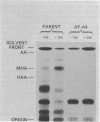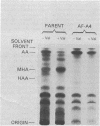Abstract
Using actinomycin-producing and nonproducing strains of Streptomyces antibioticus, I studied several steps in the biosynthetic pathway of this antibiotic. Actinomycin-nonproducing strains derived after acriflavine or novobiocin treatment showed activity of kynurenine formamidase and phenoxazinone synthase as high as that of the parental strain, but these nonproducing strains failed to convert 4-methyl-3-hydroxy-anthranilic acid to actinomycin. In addition, accumulation of 4-methyl-3-hydroxyanthranilic acid (in the presence of D-valine) was not detected in the nonproducing isolates. Actinomycin-nonproducing strains derived after acriflavine treatment of Streptomyces parvulus showed a drastic decrease of resistance to the antibiotic. However these strains regained resistance after preincubation with a small amount of actinomycin D.
Full text
PDF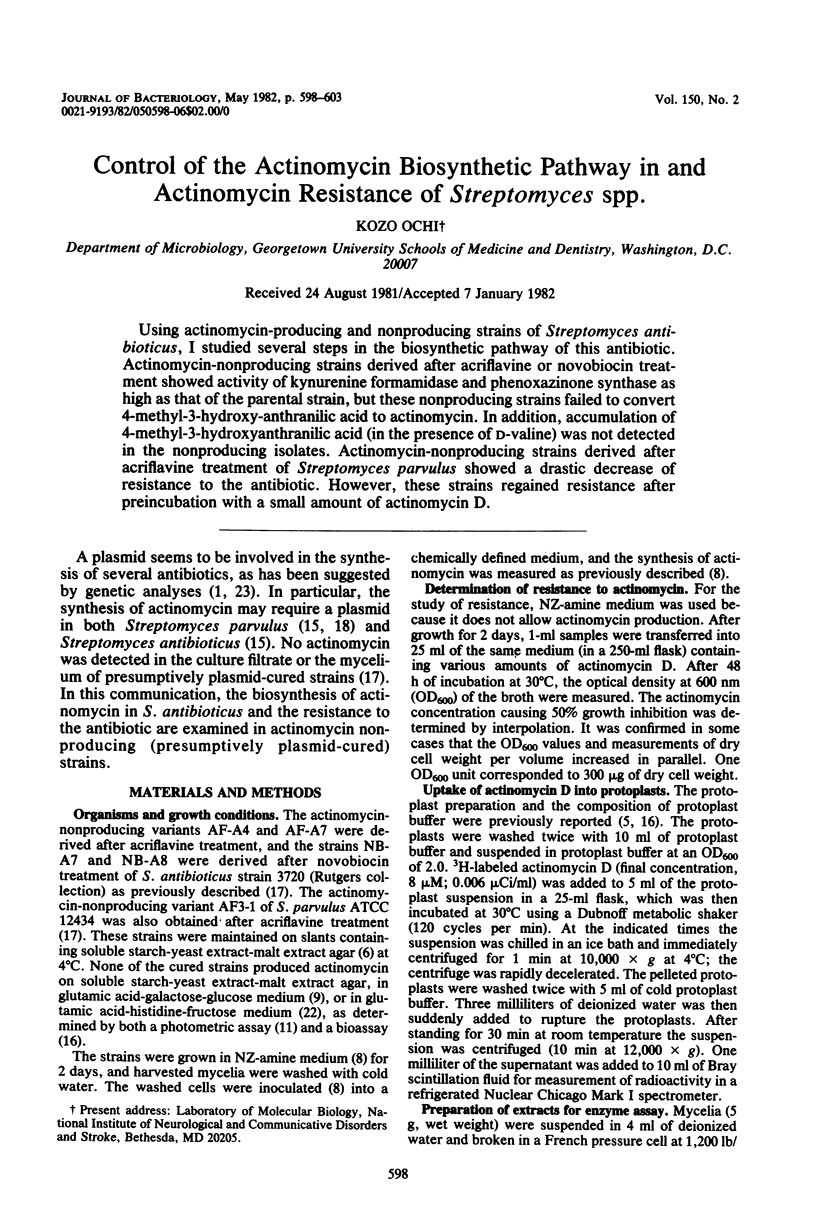
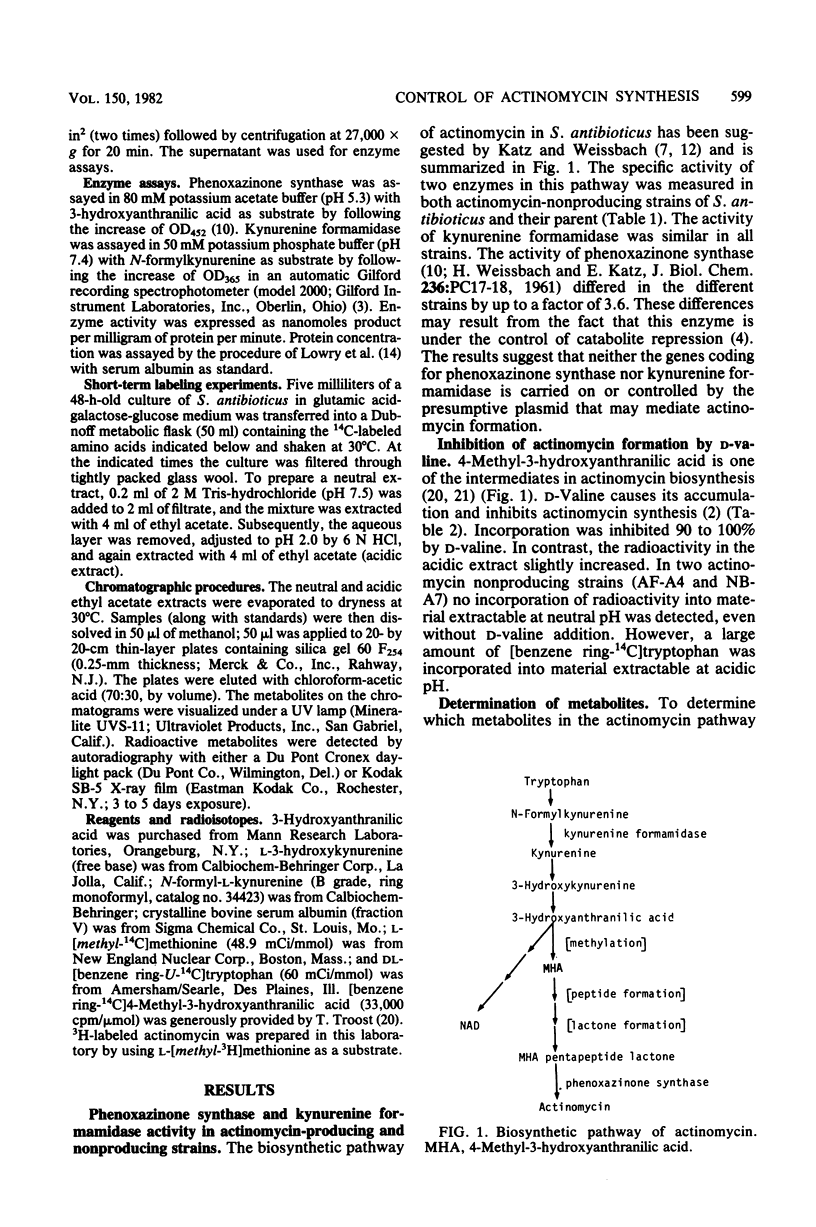
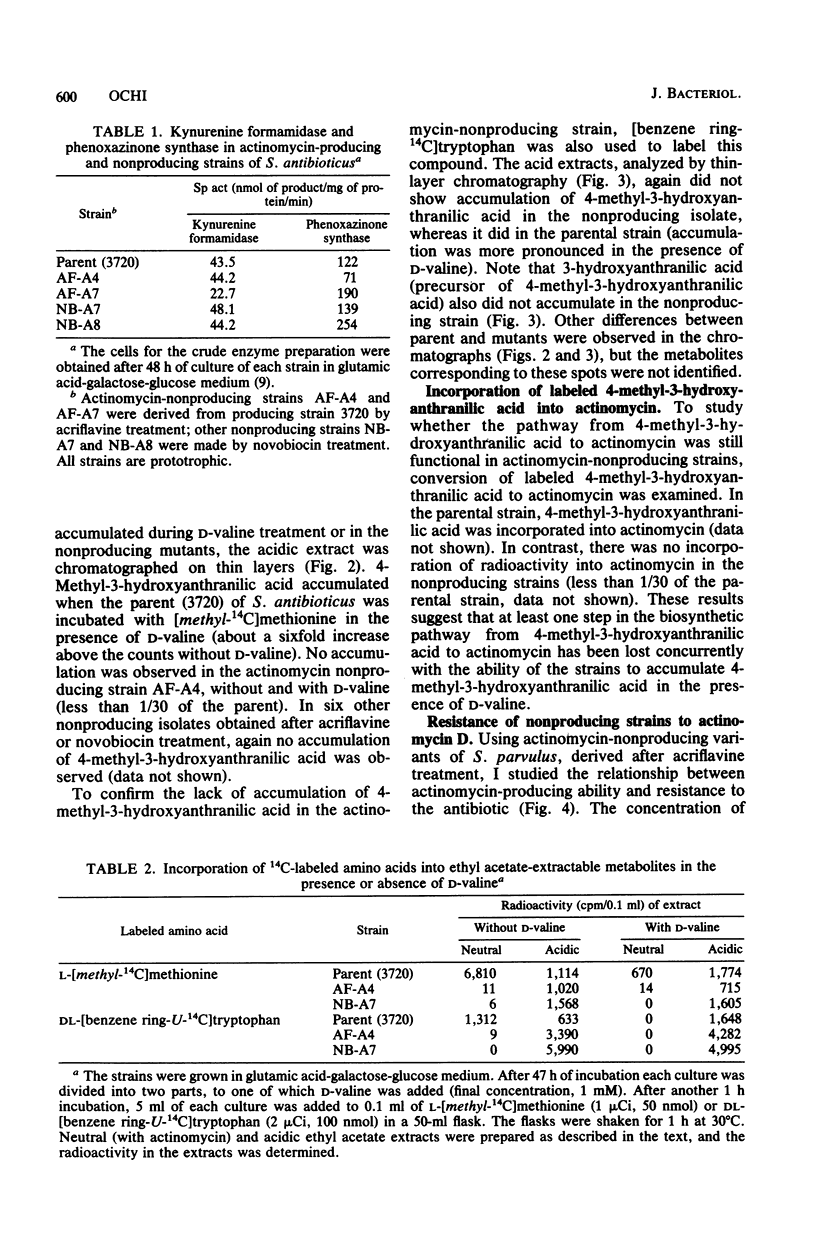
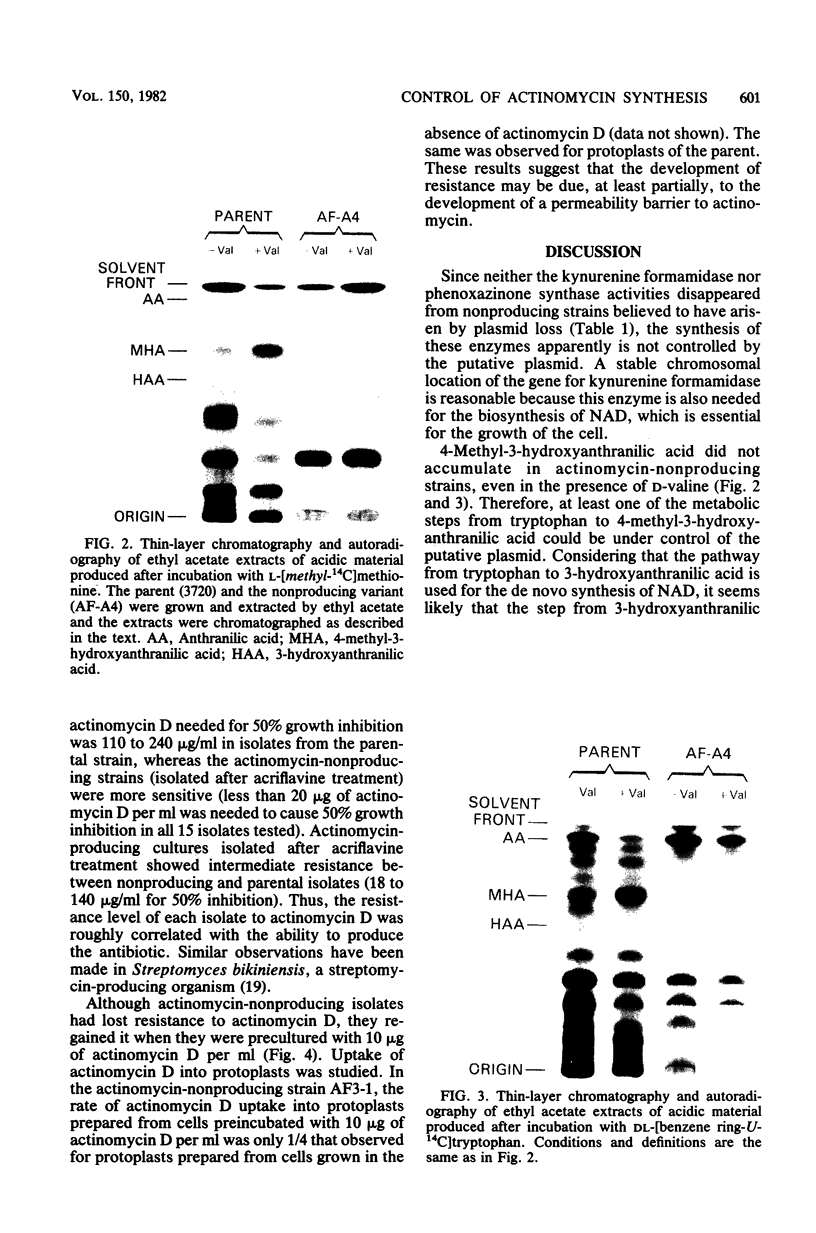
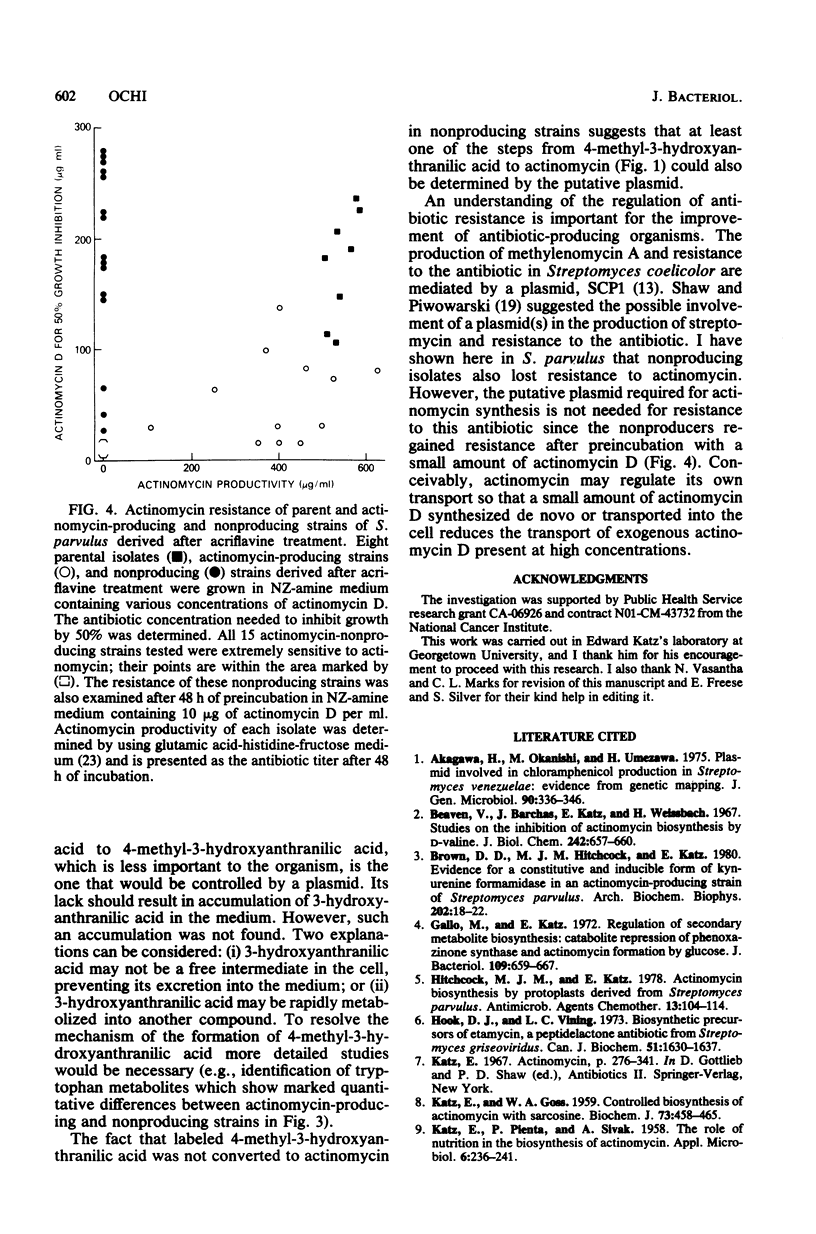
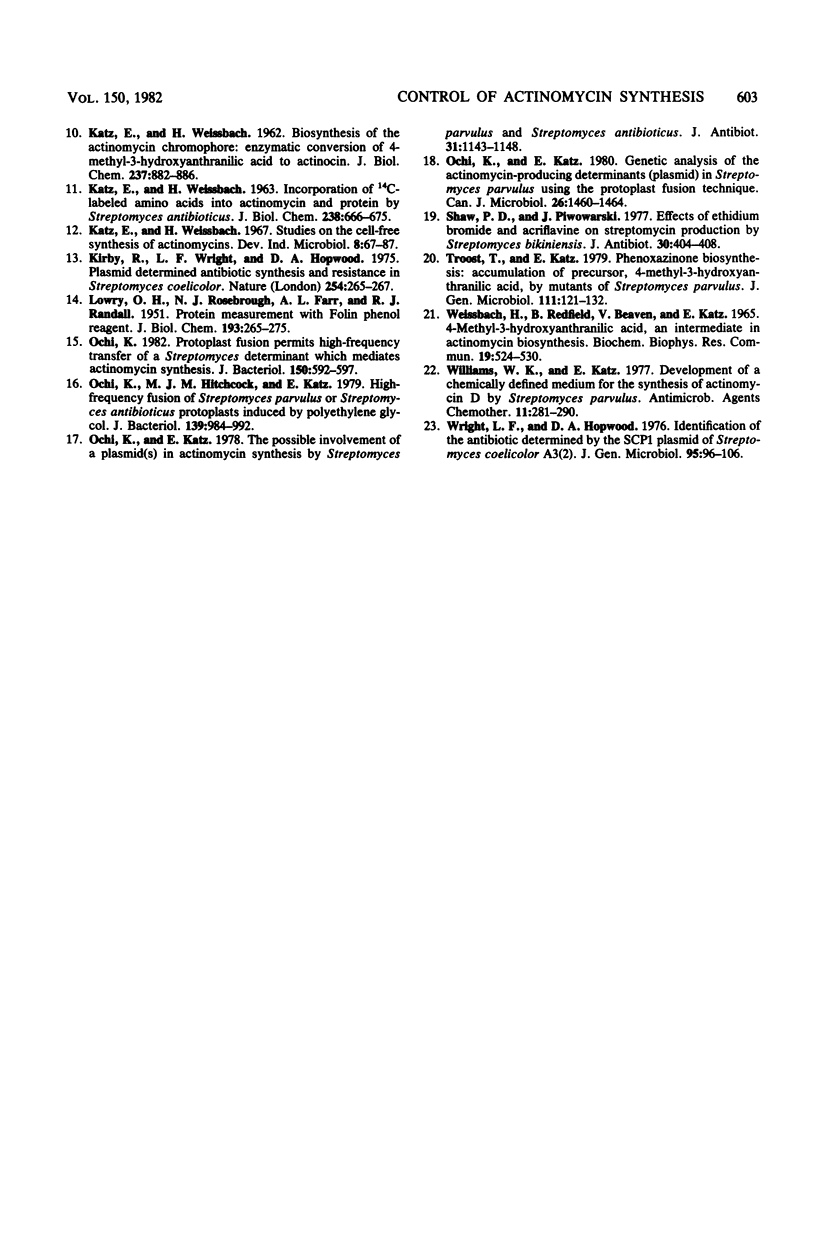
Images in this article
Selected References
These references are in PubMed. This may not be the complete list of references from this article.
- Akagawa H., Okanishi M., Umezawa H. A plasmid involved in chloramphenicol production in Streptomyces venezuelae: evidence from genetic mapping. J Gen Microbiol. 1975 Oct;90(2):336–346. doi: 10.1099/00221287-90-2-336. [DOI] [PubMed] [Google Scholar]
- Beaven V., Barchas J., Katz E., Weissbach H. Studies on the inhibition of actinomycin biosynthesis by D-valine. J Biol Chem. 1967 Feb 25;242(4):657–660. [PubMed] [Google Scholar]
- Brown D. D., Hitchcock M. J., Katz E. Evidence for a constitutive and inducible form of kynurenine formamidase in an actinomycin-producing strain of Streptomyces parvulus. Arch Biochem Biophys. 1980 Jun;202(1):18–22. doi: 10.1016/0003-9861(80)90400-2. [DOI] [PubMed] [Google Scholar]
- Gallo M., Katz E. Regulation of secondary metabolite biosynthesis: catabolite repression of phenoxazinone synthase and actinomycin formation by glucose. J Bacteriol. 1972 Feb;109(2):659–667. doi: 10.1128/jb.109.2.659-667.1972. [DOI] [PMC free article] [PubMed] [Google Scholar]
- Hitchcock M. J., Katz E. Actinomycin biosynthesis by protoplasts derived from Streptomyces parvulus. Antimicrob Agents Chemother. 1978 Jan;13(1):104–114. doi: 10.1128/aac.13.1.104. [DOI] [PMC free article] [PubMed] [Google Scholar]
- Hook D. J., Vining L. C. Biosynthetic precursors of etamycin, a peptidolactone antibiotic from Streptomyces griseoviridus. Can J Biochem. 1973 Dec;51(12):1630–1637. doi: 10.1139/o73-219. [DOI] [PubMed] [Google Scholar]
- KATZ E., GOSS W. A. Controlled biosynthesis of actinomycin with sarcosine. Biochem J. 1959 Nov;73:458–465. doi: 10.1042/bj0730458. [DOI] [PMC free article] [PubMed] [Google Scholar]
- KATZ E., PIENTA P., SIVAK A. The role of nutrition in the synthesis of actinomycin. Appl Microbiol. 1958 Jul;6(4):236–241. doi: 10.1128/am.6.4.236-241.1958. [DOI] [PMC free article] [PubMed] [Google Scholar]
- KATZ E., WEISSBACH H. Biosynthesis of the actinomycin chromophore; enzymatic conversion of 4-methyl-3-hydroxyanthranilic acid to actinocin. J Biol Chem. 1962 Mar;237:882–886. [PubMed] [Google Scholar]
- KATZ E., WEISSBACH H. Incorporation of C14-labeled amino acids into actinomycin and protein by Streptomyces antibioticus. J Biol Chem. 1963 Feb;238:666–675. [PubMed] [Google Scholar]
- Kirby R., Wright L. F., Hopwood D. A. Plasmid-determined antibiotic synthesis and resistance in Streptomyces coelicolor. Nature. 1975 Mar 20;254(5497):265–267. doi: 10.1038/254265a0. [DOI] [PubMed] [Google Scholar]
- LOWRY O. H., ROSEBROUGH N. J., FARR A. L., RANDALL R. J. Protein measurement with the Folin phenol reagent. J Biol Chem. 1951 Nov;193(1):265–275. [PubMed] [Google Scholar]
- Ochi K., Hitchcock M. J., Katz E. High-frequency fusion of Streptomyces parvulus or Streptomyces antibioticus protoplasts induced by polyethylene glycol. J Bacteriol. 1979 Sep;139(3):984–992. doi: 10.1128/jb.139.3.984-992.1979. [DOI] [PMC free article] [PubMed] [Google Scholar]
- Ochi K., Katz E. Genetic analysis of the actinomycin-producing determinants (plasmid) in Streptomyces parvulus using the protoplast fusion technique. Can J Microbiol. 1980 Dec;26(12):1460–1464. doi: 10.1139/m80-242. [DOI] [PubMed] [Google Scholar]
- Ochi K., Katz E. The possible involvement of a plasmid(s) in actinomycin synthesis by Streptomyces parvulus and Streptomyces antibioticus. J Antibiot (Tokyo) 1978 Nov;31(11):1143–1148. doi: 10.7164/antibiotics.31.1143. [DOI] [PubMed] [Google Scholar]
- Shaw P. D., Piwowarski J. Effects of ethidium bromide and acriflavine on streptomycin production by Streptomyces bikiniensis. J Antibiot (Tokyo) 1977 May;30(5):404–408. doi: 10.7164/antibiotics.30.404. [DOI] [PubMed] [Google Scholar]
- Troost T., Katz E. Phenoxazinone biosynthesis: accumulation of a precursor, 4-methyl-3-hydroxyanthranilic acid, by mutants of Streptomyces parvulus. J Gen Microbiol. 1979 Mar;111(1):121–132. doi: 10.1099/00221287-111-1-121. [DOI] [PubMed] [Google Scholar]
- WEISSBACH H., REDFIELD B., BEAVEN V., KATZ E. 4-METHYL-3-HYDROXYANTHRANILIC ACID, AN INTERMEDIATE IN ACTINOMYCIN BIOSYNTHESIS. Biochem Biophys Res Commun. 1965 May 3;19:524–530. doi: 10.1016/0006-291x(65)90157-9. [DOI] [PubMed] [Google Scholar]
- Williams W. K., Katz E. Development of a chemically defined medium for the synthesis of actinomycin D by Streptomyces parvulus. Antimicrob Agents Chemother. 1977 Feb;11(2):281–290. doi: 10.1128/aac.11.2.281. [DOI] [PMC free article] [PubMed] [Google Scholar]
- Wright L. F., Hopwood D. A. Identification of the antibiotic determined by the SCP1 plasmid of Streptomyces coelicolor A3(2). J Gen Microbiol. 1976 Jul;95(1):96–106. doi: 10.1099/00221287-95-1-96. [DOI] [PubMed] [Google Scholar]



